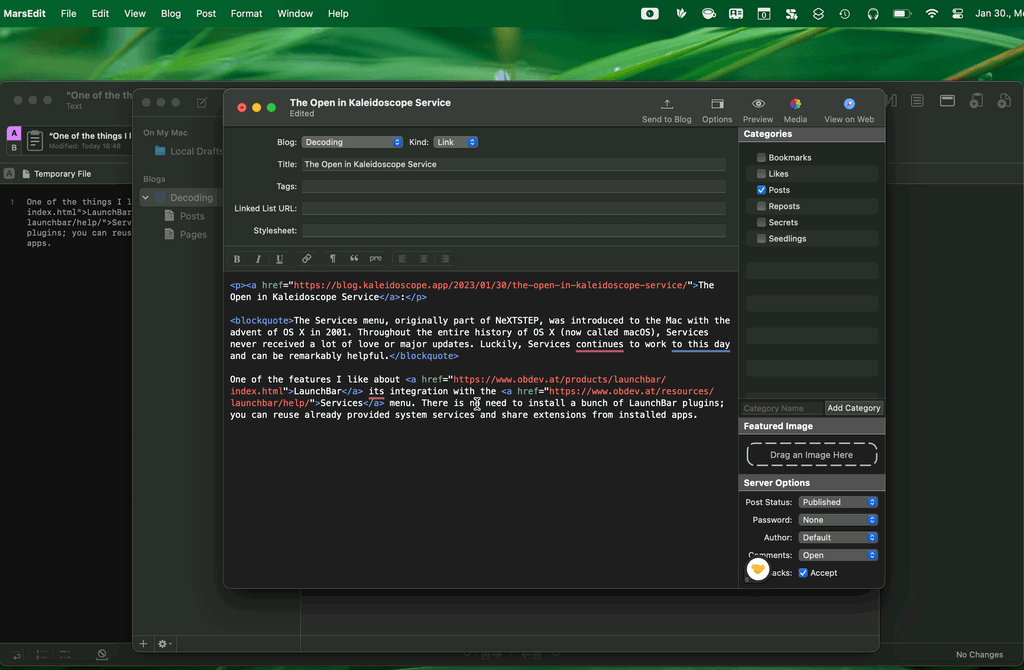Bookmarked “Montaigne“.
Make a website, blog, or portfolio using nothing but Apple Notes.
Bookmarked “Montaigne“.
Make a website, blog, or portfolio using nothing but Apple Notes.
Bookmarked “Teenage Skeuomorphic Desktop Designs“.
We can watch Chris Coyier going for a 13 minutes ride of cleaning newsletters and spam from his work inbox.
I usually try to unsubscribe from these type of emails too.
If I can, it goes into the trash. If I can’t, then it goes into spam. I don’t archive these like Chris does.
Bookmarked “Auxl“.
Auxl is a native API client for macOS. Its powerful node based system provides a whole new way to organise, test, and develop APIs.
Bookmarked “CodeEdit“.
A lightweight, natively built editor. Open source. Free forever.
The Services menu is getting a well deserved love from the Kaleidoscope blog:
The Services menu, originally part of NeXTSTEP, was introduced to the Mac with the advent of OS X in 2001. Throughout the entire history of OS X (now called macOS), Services never received a lot of love or major updates. Luckily, Services continues to work to this day and can be remarkably helpful.
One of the things I like about LaunchBar is its integration with the Services menu. There is no need to install a bunch of LaunchBar plugins; you can simply reuse already provided system services and share extensions from installed apps.

Bookmarked “My Knowledge Wiki | Everything I know“:
This is my personal wiki where I share everything I know about this world in form of an online wiki built with Docusaurus on GitHub.
Bookmarked “Grila – Calendar for keyboard addicts“:
Calendar for keyboard addicts instantly available on a hotkey
Bookmarked “Infinite Mac“.
Bookmarked “GTD Dictionary“.
Twitter Officially Bans All Third-Party Apps
Twitter today confirmed that it is no longer permitting third-party developers to create Twitter clients, with the information quietly shared in an updated developer agreement that was spotted by Engadget. A new clause under Restrictions says that developers are not able to “create a substitute or similar service or product to the Twitter Applications.”
The continued genius of Space Karen just impresses me.
This is the final nail in the coffin of Twitterrific and Tweetbot. These were great apps!
Speaking of 43 Folders:
A tickler file is an analog reminder system: a way to deliver documents and information to your future self.
Think of it as a physical mail box, linked to your calendar. Think of it as your calendar’s snail mail service.
I got a chance to talk on The Omni Show about how I use OmniFocus:
In this episode, we’re joined by Zsolt Benke, a developer from Pécs, Hungary. More than a decade ago, Zsolt started his coding life on the Web, designing and building WordPress sites. Now, he works in both web and iOS development. In his spare time, Zsolt enjoys blogging about productivity and technology, and co-hosting the podcast Agyvihar.
I think it has turned out to be a cool episode. I mentioned a couple of tricks and tips from my current system based on GTD. I hope you’ll like it!
I figured out how to get the built-in Apple Notes URL for the selected note in Hookmark (or in any app that can run Apple Scripts), so I can replace the default Hookmark script, which is a bit cumbersome.
I have a detailed write-up about the script’s inner workings in the Hookmark forums. It can be helpful even if you don’t use Hookmark. You can modify the script to copy the URL to the clipboard.
Bookmarked “WinterFest 2022“.
Got MarsEdit 5 installed.
This is why I don’t use 1Password’s custom sync engine.
I can’t stop laughing!
Get your blog and leave that Twitter bullshit to Elon Musk, the champion of free speech.
iA Presenter looks really nice.
Make Your Paper Notebooks Useful: Capture Your Ideas with a Capture Notebook
I keep my capture notebook with me at all times. It is my thoughts and ideas in-box. Interesting and useful thoughts come to me quite often when I’m on a walk, or puttering around the house.
I also keep a Capture Wallet with me most of the time.
Do you prefer the old style macOS alerts? There is a way to get them globally for AppKit in Big Sur and Monterey.
Open Terminal and paste:
defaults write -g NSAlertMetricsGatheringEnabled -bool false
If you want to restore it:
defaults delete -g NSAlertMetricsGatheringEnabled
Read “Making time to think“.
neilsardesai/Manila: A Finder extension for changing folder colors:
Manila is a Finder extension that lets you change the colors of your folders from the context menu.
Read “My Life in 3×5 – Rhoneisms“.
Bookmarked “Winnie Lim » this website as a learning and reflection tool“:
This website is essentially a repository of my memories, lessons I’ve learnt, insights I’ve discovered, a changelog of my previous selves. Most people build a map of things they have learnt, I am building a map of how I have come to be, in case I may get lost again. Maybe someone else interested in a similar lonely path will feel less alone with my documented footprints. Maybe that someone else would be me in the future. Maybe all of this would be interesting when I am dead, assuming I find a way to keep this site alive.
Portable thoughts is a website built using a single HTML file.
It simply uses URL
#fragmentsand the:targetCSS selector to show and hide “pages”. The result is a self-contained website, digital book, interactive document, or whatever you want to call it.
So, you have a single HTML file that contains everything and is easily navigable without any JavaScript by just showing and hiding sections via CSS. This is smart.
I don’t know what I’m going to use this idea yet, but it will be useful one day.